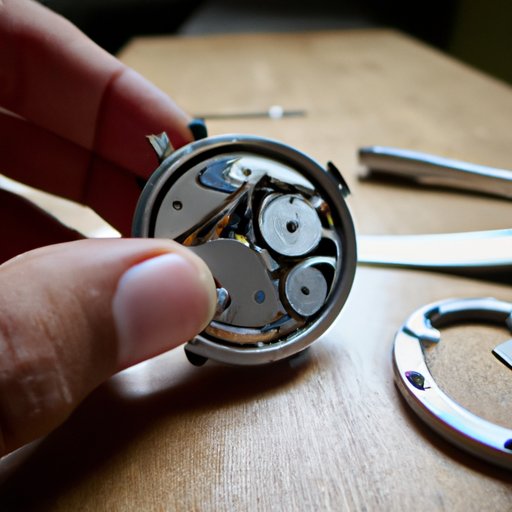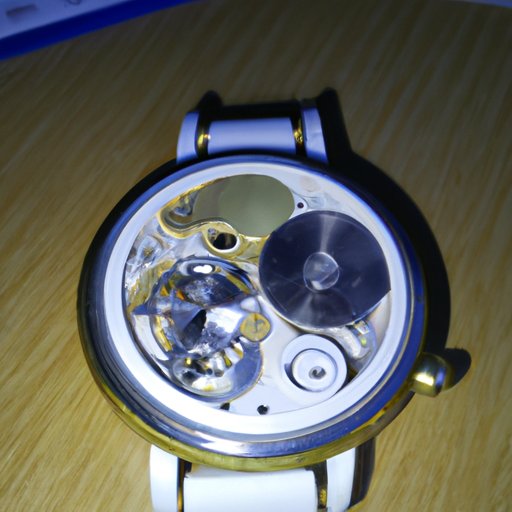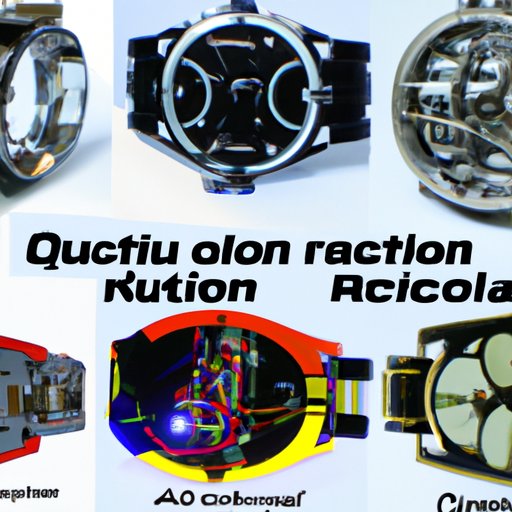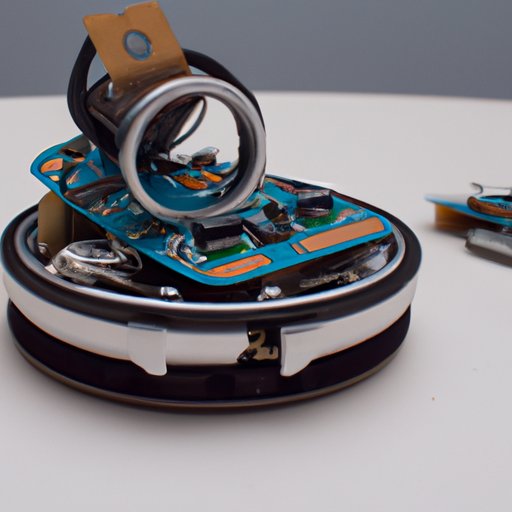Introduction
A quartz watch is an electronic timekeeping device that uses electricity to power its movements. The name “quartz” comes from the fact that it utilizes a quartz crystal to help keep accurate time. Quartz watches are becoming increasingly popular due to their accuracy and affordability.
In this article, we will explore how a quartz watch works and examine the components and mechanics behind quartz technology. We will also look at the benefits of quartz watches over mechanical timepieces and provide an overview of the topic.

Exploring the Components of a Quartz Watch
A quartz watch contains several components, each of which plays an important role in its operation. These components include a battery, an oscillator, and a stepping motor.
Battery
The battery provides the electric current needed to power the quartz watch. It is usually a small button-cell lithium battery that has a long life span.
Oscillator
The oscillator is a tiny piece of quartz crystal that vibrates at a precise frequency when an electric current is applied to it. This frequency is what keeps the watch running accurately.
Stepping Motor
The stepping motor is responsible for turning the quartz crystal’s vibrations into motion. It translates the vibration into a series of pulses, which then turn the hands on the watch face.

How Quartz Movements Power Watches
When an electric current is sent to the quartz crystal, it causes the crystal to vibrate at a very precise frequency. This frequency is measured in hertz (Hz). According to a study by the National Institute of Standards and Technology, the typical quartz crystal oscillates at 32,768 Hz.
The oscillator frequency is then used to power the stepping motor, which translates the vibration into a series of pulses. These pulses cause the hands on the watch face to move. The quartz watch movement is powered by the electric current from the battery.

An Overview of Quartz Technology in Wristwatches
Quartz technology has become increasingly popular in wristwatches over the past few decades. Quartz watches are more accurate than mechanical watches, and they are also much cheaper to produce. Quartz watches use a quartz crystal to keep time, as opposed to a mechanical movement.
The Quartz Crystal
The quartz crystal is a small piece of quartz that vibrates at a precise frequency when an electric current is applied to it. This frequency is what keeps the watch running accurately.
Digital Display
Quartz watches typically have a digital display, which makes them easier to read than mechanical watches. Digital displays are also more energy efficient, since they don’t require as much power to operate.
How the Quartz Crystal Keeps Time
The quartz crystal inside a quartz watch vibrates at a precise frequency when an electric current is applied to it. This frequency is measured in hertz (Hz). According to a study by the National Institute of Standards and Technology, the typical quartz crystal oscillates at 32,768 Hz.
The quartz crystal’s vibrations are regulated by a tiny circuit board. This circuit board helps keep the quartz crystal oscillating at the same speed, which ensures that the watch keeps accurate time.
Understanding the Mechanics Behind Quartz Watches
The mechanics behind quartz watches are relatively simple. A quartz watch contains a battery, an oscillator, and a stepping motor. The battery supplies the electric current needed to power the quartz watch, and the oscillator is a tiny piece of quartz crystal that vibrates at a precise frequency. The stepping motor translates the vibration into a series of pulses, which then turn the hands on the watch face.
The quartz crystal is regulated by a tiny circuit board, which helps keep the quartz crystal oscillating at the same speed. This ensures that the watch keeps accurate time.
In addition, quartz watches contain a microchip and circuitry that allow them to perform more complex tasks than mechanical watches. These tasks include displaying the time and date, setting alarms, and calculating elapsed time.
The Benefits of Quartz Watches over Mechanical Timepieces
Quartz watches offer several advantages over mechanical timepieces. They are much more accurate than mechanical watches, since they use a quartz crystal to keep time. Quartz watches are also much more durable than mechanical watches, since there are fewer moving parts that can break or wear out over time.
Finally, quartz watches are much cheaper to produce than mechanical watches. This makes them more affordable for consumers.
Conclusion
In conclusion, quartz watches are becoming increasingly popular due to their accuracy and affordability. They contain several components, including a battery, an oscillator, and a stepping motor. The quartz crystal inside a quartz watch vibrates at a precise frequency when an electric current is applied to it, and this frequency is regulated by a tiny circuit board. Quartz watches also contain a microchip and circuitry that allow them to perform more complex tasks than mechanical watches.
Quartz watches offer several advantages over mechanical timepieces, such as accuracy, durability, and price. In this article, we have explored how a quartz watch works and examined the components and mechanics behind quartz technology.
(Note: Is this article not meeting your expectations? Do you have knowledge or insights to share? Unlock new opportunities and expand your reach by joining our authors team. Click Registration to join us and share your expertise with our readers.)
